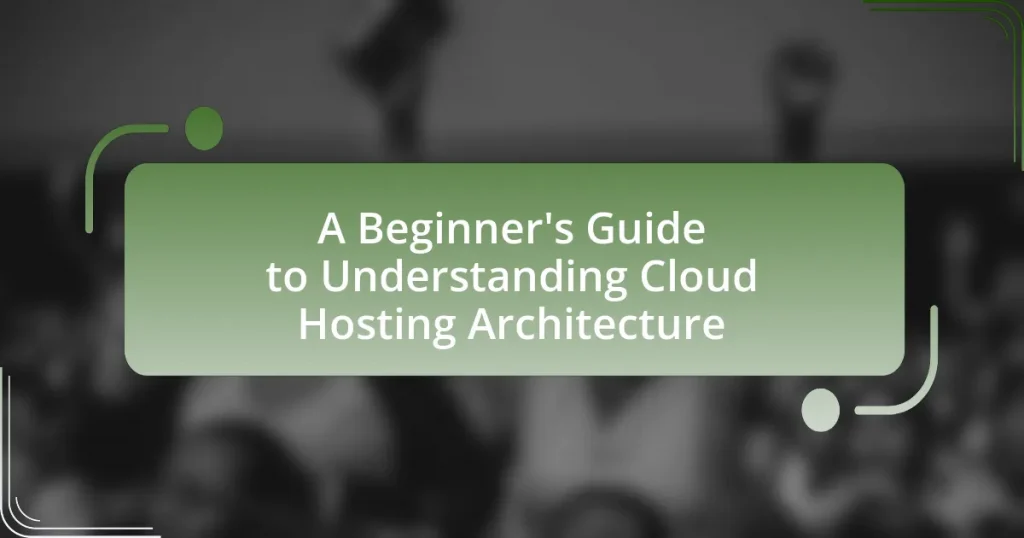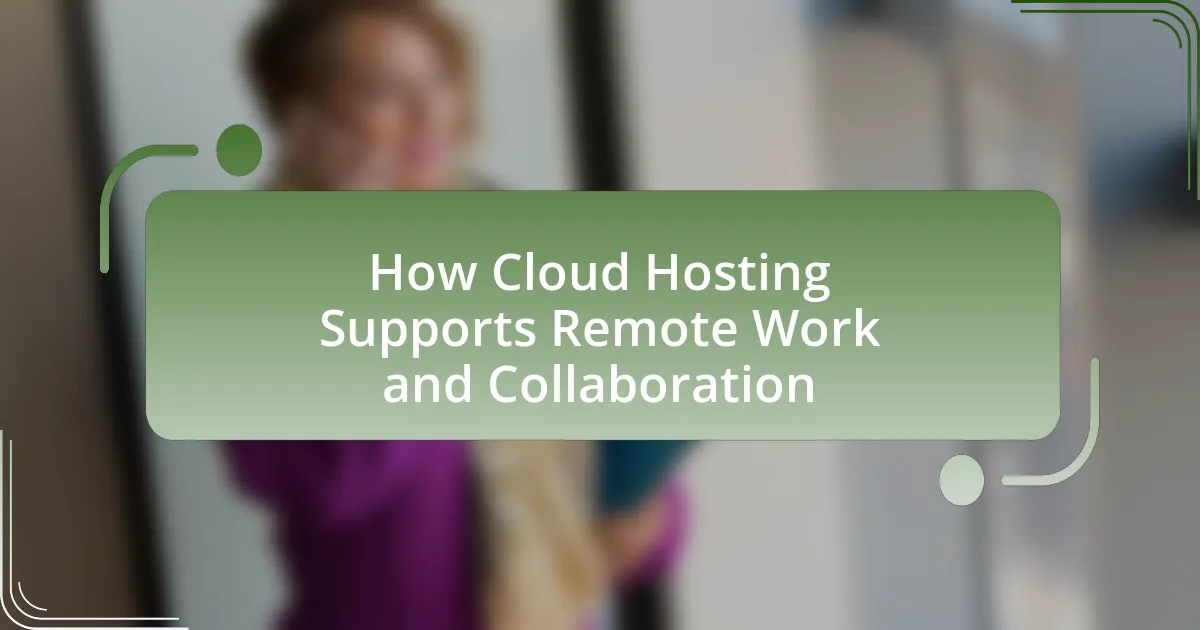Cloud hosting architecture is a framework that employs multiple interconnected servers to host websites and applications, offering enhanced scalability, reliability, and flexibility compared to traditional hosting methods. This article provides a comprehensive overview of cloud hosting architecture, detailing its key components, types, and the differences between public, private, and hybrid cloud hosting. It also addresses the importance of scalability, security measures, and best practices for implementation, while highlighting the cost advantages and performance optimization strategies associated with cloud hosting. Additionally, the article discusses common challenges and troubleshooting techniques, making it a valuable resource for beginners seeking to understand cloud hosting architecture.

What is Cloud Hosting Architecture?
Cloud hosting architecture is a framework that utilizes multiple servers to host websites and applications, providing scalability, reliability, and flexibility. This architecture distributes resources across a network of interconnected servers, allowing for efficient load balancing and redundancy. For instance, if one server fails, another can take over, ensuring minimal downtime. The use of virtualization technology enables the creation of virtual servers, which can be easily scaled up or down based on demand, making cloud hosting a cost-effective solution for businesses.
How does Cloud Hosting Architecture differ from traditional hosting?
Cloud Hosting Architecture differs from traditional hosting primarily in its resource allocation and scalability. In traditional hosting, resources such as CPU, RAM, and storage are fixed and tied to a single server, which can lead to limitations in performance and flexibility. In contrast, cloud hosting utilizes a network of interconnected servers, allowing for dynamic resource allocation based on demand, which enhances scalability and reliability. This architecture enables businesses to easily scale up or down their resources as needed, ensuring optimal performance during peak times without the risk of server overload. Additionally, cloud hosting often incorporates redundancy and failover mechanisms, improving uptime and data security compared to traditional hosting setups.
What are the key components of Cloud Hosting Architecture?
The key components of Cloud Hosting Architecture include virtualization, storage, networking, and management tools. Virtualization allows multiple virtual machines to run on a single physical server, optimizing resource utilization. Storage systems, such as block storage and object storage, provide scalable data management solutions. Networking components ensure connectivity and data transfer between servers and clients, often utilizing load balancers and firewalls for security and performance. Management tools facilitate monitoring, automation, and orchestration of cloud resources, enabling efficient operation and scaling of services. These components work together to create a flexible, scalable, and efficient cloud hosting environment.
Why is scalability important in Cloud Hosting Architecture?
Scalability is crucial in Cloud Hosting Architecture because it allows systems to efficiently handle varying workloads and user demands. This flexibility ensures that resources can be adjusted dynamically, enabling businesses to accommodate growth without significant downtime or performance degradation. For instance, a study by Gartner indicates that organizations leveraging scalable cloud solutions can reduce infrastructure costs by up to 30% while improving service delivery. This adaptability not only enhances user experience but also supports business continuity and innovation in rapidly changing markets.
What are the main types of Cloud Hosting?
The main types of cloud hosting are public cloud, private cloud, hybrid cloud, and multi-cloud. Public cloud hosting involves services offered over the public internet, allowing multiple users to share resources, which can lead to cost efficiency. Private cloud hosting provides dedicated resources for a single organization, enhancing security and control. Hybrid cloud hosting combines both public and private clouds, enabling data and applications to be shared between them for flexibility. Multi-cloud hosting utilizes multiple cloud services from different providers to avoid vendor lock-in and enhance redundancy. Each type serves distinct needs based on factors like scalability, security, and cost.
What is the difference between public, private, and hybrid cloud hosting?
Public cloud hosting is a service where resources are provided over the internet by third-party providers and shared among multiple users, such as Amazon Web Services and Microsoft Azure. Private cloud hosting, in contrast, involves dedicated resources for a single organization, offering greater control and security, often hosted on-premises or through a private data center. Hybrid cloud hosting combines elements of both public and private clouds, allowing data and applications to be shared between them, which provides flexibility and scalability while maintaining security for sensitive data. This differentiation is crucial for organizations to choose the right cloud solution based on their specific needs for security, control, and resource management.
How do different types of cloud hosting impact performance?
Different types of cloud hosting significantly impact performance through variations in resource allocation, scalability, and infrastructure. For instance, public cloud hosting typically offers shared resources, which can lead to variable performance depending on the load from other users, while private cloud hosting provides dedicated resources, resulting in more consistent performance. Hybrid cloud solutions combine both, allowing for flexibility and optimized performance based on specific workloads. According to a study by Gartner, organizations using private clouds reported a 20-30% improvement in application performance compared to those using public clouds, highlighting the importance of choosing the right type of cloud hosting for performance needs.
What are the benefits of using Cloud Hosting Architecture?
Cloud Hosting Architecture offers scalability, flexibility, and cost-effectiveness. Scalability allows businesses to easily adjust resources based on demand, ensuring optimal performance during peak times. Flexibility enables users to access their applications and data from anywhere, facilitating remote work and collaboration. Cost-effectiveness is achieved through a pay-as-you-go model, which reduces the need for significant upfront investments in hardware. According to a report by Gartner, organizations can save up to 30% on IT costs by migrating to cloud services, validating the financial benefits of cloud hosting.
How does Cloud Hosting Architecture enhance flexibility and scalability?
Cloud Hosting Architecture enhances flexibility and scalability by utilizing a distributed network of servers that can dynamically allocate resources based on demand. This architecture allows businesses to easily scale their computing power up or down without the need for physical hardware changes, enabling rapid adjustments to traffic fluctuations. For instance, during peak usage times, additional resources can be provisioned automatically, ensuring optimal performance. Conversely, during low-demand periods, resources can be reduced, leading to cost savings. This on-demand resource allocation is supported by virtualization technologies, which allow multiple virtual servers to run on a single physical server, further optimizing resource use and enhancing overall system flexibility.
What cost advantages does Cloud Hosting Architecture provide?
Cloud Hosting Architecture provides significant cost advantages, primarily through reduced infrastructure expenses and pay-as-you-go pricing models. Organizations can eliminate the need for physical servers and maintenance costs, as cloud providers manage the hardware and software infrastructure. This model allows businesses to scale resources up or down based on demand, ensuring they only pay for what they use, which can lead to substantial savings. According to a study by Gartner, companies can save up to 30% on IT costs by migrating to cloud services, highlighting the financial benefits of adopting cloud hosting solutions.
How does security work in Cloud Hosting Architecture?
Security in Cloud Hosting Architecture is implemented through a multi-layered approach that includes data encryption, access controls, and regular security audits. Data encryption protects sensitive information both at rest and in transit, ensuring that unauthorized users cannot access it. Access controls, such as identity and access management (IAM), restrict user permissions based on roles, minimizing the risk of data breaches. Regular security audits and compliance checks help identify vulnerabilities and ensure adherence to industry standards, such as ISO 27001 and GDPR. This comprehensive strategy is essential for maintaining the integrity and confidentiality of data in cloud environments.
What are the common security challenges in Cloud Hosting?
Common security challenges in cloud hosting include data breaches, account hijacking, insecure APIs, and insufficient due diligence. Data breaches occur when unauthorized individuals gain access to sensitive information stored in the cloud, which has been a significant concern, with reports indicating that 60% of companies experienced a data breach in the past year. Account hijacking involves attackers gaining control of user accounts, often through phishing or weak passwords, leading to unauthorized access to cloud resources. Insecure APIs can expose vulnerabilities, as many cloud services rely on APIs for functionality, making them potential targets for exploitation. Insufficient due diligence refers to the lack of thorough security assessments and compliance checks by organizations when selecting cloud service providers, which can lead to inadequate security measures being implemented.
How can users ensure data protection in Cloud Hosting?
Users can ensure data protection in Cloud Hosting by implementing strong encryption protocols for data at rest and in transit. Encryption safeguards sensitive information from unauthorized access, making it unreadable without the correct decryption key. According to a 2021 report by the Cloud Security Alliance, 64% of organizations that adopted encryption in cloud environments reported a significant reduction in data breaches. Additionally, users should regularly update access controls and permissions, ensuring that only authorized personnel can access sensitive data. Regular audits and compliance checks further enhance data protection by identifying vulnerabilities and ensuring adherence to security standards.
What are the best practices for implementing Cloud Hosting Architecture?
The best practices for implementing Cloud Hosting Architecture include designing for scalability, ensuring security, optimizing performance, and implementing effective monitoring. Designing for scalability allows systems to handle increased loads efficiently, which is crucial as user demand grows. Security measures, such as encryption and access controls, protect sensitive data and maintain compliance with regulations. Optimizing performance involves selecting the right resources and configurations to minimize latency and maximize throughput. Effective monitoring enables proactive management of resources and quick identification of issues, ensuring high availability and reliability. These practices are supported by industry standards and frameworks, such as the Cloud Security Alliance’s guidelines, which emphasize the importance of security and compliance in cloud environments.
How can businesses choose the right cloud service provider?
Businesses can choose the right cloud service provider by evaluating their specific needs, including scalability, security, compliance, and cost. First, they should assess their current and future workload requirements to determine the necessary scalability features. Next, security measures such as data encryption, access controls, and compliance with regulations like GDPR or HIPAA must be considered, as these are critical for protecting sensitive information. Additionally, businesses should compare pricing models and total cost of ownership among providers to ensure they align with their budget. According to a 2021 report by Gartner, 70% of organizations cite cost as a primary factor in selecting a cloud provider, highlighting the importance of financial considerations in the decision-making process.
What strategies can optimize performance in Cloud Hosting?
To optimize performance in cloud hosting, implementing strategies such as auto-scaling, load balancing, and utilizing Content Delivery Networks (CDNs) is essential. Auto-scaling adjusts resources dynamically based on demand, ensuring that applications maintain performance during traffic spikes. Load balancing distributes incoming traffic across multiple servers, preventing any single server from becoming a bottleneck. CDNs enhance performance by caching content closer to users, reducing latency and improving load times. According to a study by Akamai, using a CDN can improve website load times by up to 50%, demonstrating the effectiveness of these strategies in enhancing cloud hosting performance.
What common issues might arise with Cloud Hosting Architecture?
Common issues that might arise with Cloud Hosting Architecture include security vulnerabilities, downtime, and vendor lock-in. Security vulnerabilities can occur due to misconfigurations or inadequate access controls, leading to data breaches; for instance, a 2020 report by McAfee indicated that 21% of organizations experienced a cloud security incident. Downtime can result from server failures or maintenance, impacting service availability; according to a 2021 study by Gartner, unplanned outages can cost businesses an average of $5,600 per minute. Vendor lock-in happens when businesses become dependent on a single cloud provider’s services, making it difficult to switch providers without incurring significant costs or operational disruptions.
How can users troubleshoot connectivity problems in Cloud Hosting?
Users can troubleshoot connectivity problems in Cloud Hosting by systematically checking network configurations, server status, and firewall settings. First, users should verify their internet connection to ensure it is stable and functioning. Next, they should check the cloud service provider’s status page for any ongoing outages or maintenance that could affect connectivity. Additionally, users must confirm that their server is running and accessible by using tools like ping or traceroute to identify where the connection fails. Lastly, reviewing firewall settings is crucial, as misconfigured rules can block access to the cloud resources. These steps are effective because they address common issues that can disrupt connectivity, ensuring users can identify and resolve problems efficiently.
What steps can be taken to resolve performance issues in Cloud Hosting?
To resolve performance issues in cloud hosting, one should first assess resource allocation and optimize it based on usage patterns. This involves monitoring CPU, memory, and bandwidth utilization to identify bottlenecks. Implementing auto-scaling can dynamically adjust resources based on demand, ensuring optimal performance during peak times. Additionally, utilizing content delivery networks (CDNs) can reduce latency by caching content closer to users. Regularly updating software and applications can also enhance performance by fixing bugs and improving efficiency. According to a study by Gartner, optimizing resource allocation can lead to a 30% improvement in application performance, validating the effectiveness of these steps.
What tips should beginners consider when exploring Cloud Hosting Architecture?
Beginners exploring Cloud Hosting Architecture should prioritize understanding the fundamental concepts of cloud computing, including the differences between IaaS, PaaS, and SaaS. Familiarizing oneself with these service models is crucial, as they dictate how resources are managed and billed. Additionally, beginners should learn about scalability and elasticity, which are key advantages of cloud hosting, allowing businesses to adjust resources based on demand. Security is another critical aspect; understanding shared responsibility models and implementing best practices for data protection is essential. Finally, beginners should experiment with various cloud platforms, such as AWS, Azure, or Google Cloud, to gain hands-on experience and better understand the practical applications of cloud architecture.




